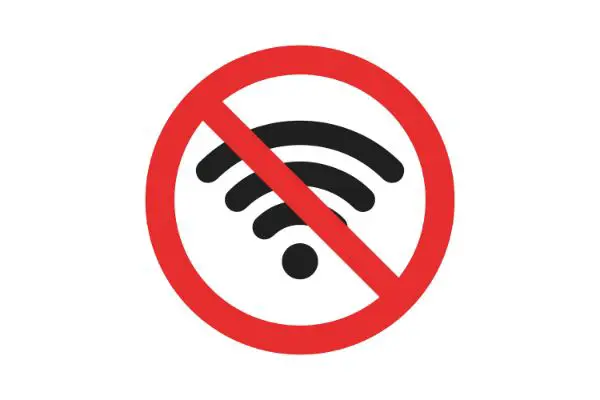Disclaimer: This post may contain affiliate links, meaning we get a small commission if you make a purchase through our links, at no cost to you. For more information, please visit our Disclaimer Page.
We’ve all been there before. You’re trying to watch a movie or finish up some work on your laptop, but the Wi-Fi signal is constantly dropping out. This can be incredibly frustrating, especially if you have an important deadline to meet.
There are several ways to block other Wi-Fi signals or networks. We can do this by using a firewall, disabling specific networks or we can also use physical solutions such as a Wi-Fi blocker, physical firewall.
In this blog post, we will discuss how to block Wi-Fi signals from other networks.
Let’s get into the details in the following sections.
Table of Contents
Can You Block Other Wi-Fi Signals?
Wi-Fi signals are electromagnetic waves that are broadcasted from your router. These waves are then received by your devices, which allow them to connect to the internet.
It is possible to block specific Wi-Fi Signals on your device and thus prevent your device from connecting to the blocked Wi-Fi access point. This can be done by using a Wi-Fi blocker or by changing the settings on your device.
Using electromagnetic blocking materials, you risk blocking the Wi-Fi that you need, so it is not a recommended method.
3 Types of Ways to Block Wi-Fi Networks
There are a few methods that you can use to block other Wi-Fi networks from connecting to your device:
Physical Wi-Fi blockers: These are physical objects that you can place or build between your router and your devices in order to block the signal. Signal Boosters has a great article on materials that can interfere with Wi-Fi signals.
Software Wi-Fi blockers: These are programs that you can install on your devices in order to block the signal.
Firewalls: Firewalls can be used to block specific IP addresses from accessing your network.
How Can I Block My Neighbor’s Wi-Fi Signal? (7 Ways)
This can be a common issue if you live in an apartment or in the city.
If you’re experiencing low signal strength, or if you’re trying to prevent other people from using your network, there are a few ways that you can block Wi-Fi signals
1. Directly Connect Via an Ethernet Cable
One way is to use an Ethernet cable to physically attach your device to the router.
This will create a closed circuit and will block any other signals from entering.
Then just turn your Wi-Fi receiver off to completely block Wi-Fi on your devices. The problem with this method is that you cannot use Wi-Fi on other devices that are not connected.
2. Software Firewall
Another way to block Wi-Fi signals is by using a software firewall. Configuring settings will allow you to specifically block certain devices or networks from connecting.
For this method, you’d be purchasing a monthly subscription. This is no doubt one of the easier methods.
It’s cheaper than the hardware solution in the short term and requires no physical space since that can be a common issue with living in apartments.
The downside of software firewalls is that they take up space on your computer. It can also be more prone to cyber security attacks and some subscriptions out there can’t be configured to where you can mask your IP addresses.
3. Hardware Firewall
You can also use a hardware firewall, which is a physical device that you can plug into your router. This will create a barrier between your network and any outside signals.
The biggest benefit of this is that one of these devices can protect your entire network. With a software firewall, if you have multiple devices, you may need to pay for a higher subscription price.
This method can also be expensive if you are looking for a quality one to protect only a few devices.
4. Use Another Frequency Channel
Each Wi-Fi frequency has its unique channels. While the 5GHz range has 23 or more channels, the 2.4GHz has only 11.
Sometimes, switching frequencies can be difficult because of router constraints. So you should try switching to a different channel before considering purchasing another router.
To get better results, you need to carefully observe and know the most occupied channel in your vicinity. You can use the apps or programs available for this type of analysis or try experimenting with the different channels.
The popular channels for the 2.4GHz frequency are 11, 6, and 1. While the most popular channels for the 5GHz are 48, 44, 40, and 36. Remember that frequency channels won’t necessarily follow a sequential pattern.
The first step in switching channels is to log into your specific Wi-Fi network. Next, enter your router’s IP address into your web browser and tap the search button. Should a warning page appear, tap “Advanced” then “proceed”.
Your username and password will be requested; enter them to log in. Once on the Wi-Fi site, locate the “wireless settings”, open it and tap the “channels” drop-down menu. You can now change from the default channel to your preferred channel, then save the changes.
Tip: You could perform all the above-suggested techniques for a more comprehensive and effective result.
5. Disable Specific Wireless Network on Windows
Windows allows you to block specific access points. Go to your network settings and select the Network and Sharing Center.
Now, enter the Adapter Settings and disable the Wireless Network you need to disable.
On YouTube, there’s a good video by Liron Segev on how to specifically block neighbor’s Wi-Fi. He shows us 2 methods using the command prompt.
6. Disable Specific Wireless Network on MAC
Similarly, for MAC, open the System Preferences and then go to the Network.
Select Wi-Fi from the left sidebar and then click on the gear icon next to the wireless network you want to disable.
On YouTube, there’s a good video by Apple Ninja, to help block Wi-Fi users.
This is pretty helpful if your neighbor happens to be using your Wi-Fi. In addition, there’s a informative video by Ask Leo, that can help discuss other methods to preventing users from using your Wi-Fi.
7. Forget Network on Mobile Devices
This will delete the network from your list of available networks.
To do this on an iPhone, go to Settings-> Wi-Fi and then tap on the “Forget This Network” button.
For Android, go to Settings-> Wireless & Networks-> Wi-Fi Settings and long press on the network you want to forget.
These were a few easy ways that you can block other Wi-Fi signals from connecting to your device.
Improve Your Wi-Fi Signal Strength
If you’re having trouble with your Wi-Fi signal strength, there are a few things that you can do to boost it:
- Change the position of your router: If you have a weak signal, try moving your router to a different location.
- Update your firmware: Check to see if there’s a new version of firmware for your router and update it.
- Change the channel: If there are other networks in the area that are using the same channel as you, try changing your channel to avoid interference.
- Use a range extender: A range extender can help boost your signal if you have a large home or office.
These are just a few tips that can help improve your Wi-Fi signal strength. By following these tips, you can ensure that you have the best possible connection.
How Do I Block Wi-Fi Outside My House?
If you’re trying to block Wi-Fi signals from outside your house, there are a few things that you can do:
Use a Faraday Cage
A Faraday cage is a metal enclosure that blocks electromagnetic fields. You can use this to block Wi-Fi signals by building a metal mesh on your doors and windows.
This is not a very practical solution, but it will work if you’re trying to block Wi-Fi signals from a specific area.
Use a Wi-Fi Blocker
A Wi-Fi blocker is a device that emits an electromagnetic field in the opposing frequency as the Wi-Fi signal.
This will cause interference and will block the Wi-Fi signal. Wi-Fi blockers are legal in most countries, so they are a more practical solution than an RF jammer.
Change the Position of Your Router
If you have the option, try to position your router in a central location in your house. This will help to reduce the strength of the signal that reaches outside.
Use a Wi-Fi Blocker App
There are a number of apps available that claim to be able to block Wi-Fi signals. While there is no guarantee that these apps will work, they may be worth a try.
Install Metal Foil
You can also try to block Wi-Fi signals by installing metal foil on your doors and windows.
This is again not a very practical solution, but it may work if you’re trying to block Wi-Fi signals from a specific area.
Redirect Your Router Antenna
If you have an antenna on your router, you can use it to direct the Wi-Fi signal away from your house.
This will help to reduce the strength of the signal that reaches outside.
The most practical way to deter your neighbors from jumping onto your Wi-Fi is to password protect your network.
By doing this, you make it much harder for people to access your Wi-Fi without your permission. You can also try to talk to your neighbors and ask them politely to not use your Wi-Fi.
While this may not always work, it’s worth a try.
Final Thoughts
Blocking Wi-Fi signals can be useful in several situations.
Whether you’re trying to stop your neighbors from using your Wi-Fi or you’re trying to improve your signal strength, there are several ways that you can go about it.
By following the tips in this article, you can ensure that you have the best possible connection.


